British Weapons & Equipment
to oppose Operation Sealion (Seelöwe)
British weapons that were available to oppose Operation Sealion were basically those that had been available for the BEF and the Defence of France. These are so well documented that there is no need to cover them here. What I will describe is those special weapons that were designed to meet the acute need after the evacuation of Dunkirk and which might have been available in time for Seelöwe.
The Beaverette was first built in 1940 by Standard Motor Company at the instigation of Lord Beaverbrook. The Air Ministry had a requirement for light armoured cars to defend their airfields. It was issued to the RAF regiment and the Home Guard and even to some regular army cavalry regiments (including the 4th/7th Royal Dragoon Guards) due to shortages of their regulation equipment.
It was based on a commercial 4x2 car chassis of which Standard had 500 left over when car production ceased for the duration of the hostilities. It had a body of riveted 1/3-inch (11 mm) steel plates backed by 3 inch thick oak planks. This use of flat rivited steel plates made it easy to design and build.
It was open topped and open at the rear. It had a crew of 3.
It was armed with a forward firing Bren .303in light machine gun or Boys .55in anti-tank rifle.
It was critically underpowered by a four-cylinder 46-hp engine giving the two-ton car a top speed of 24 mph (38 km/h).
Later models had more armour and a turret mounted Bren or dual-Vickers machine gun.
Production stopped in 1942 after 2,800 had been delivered.
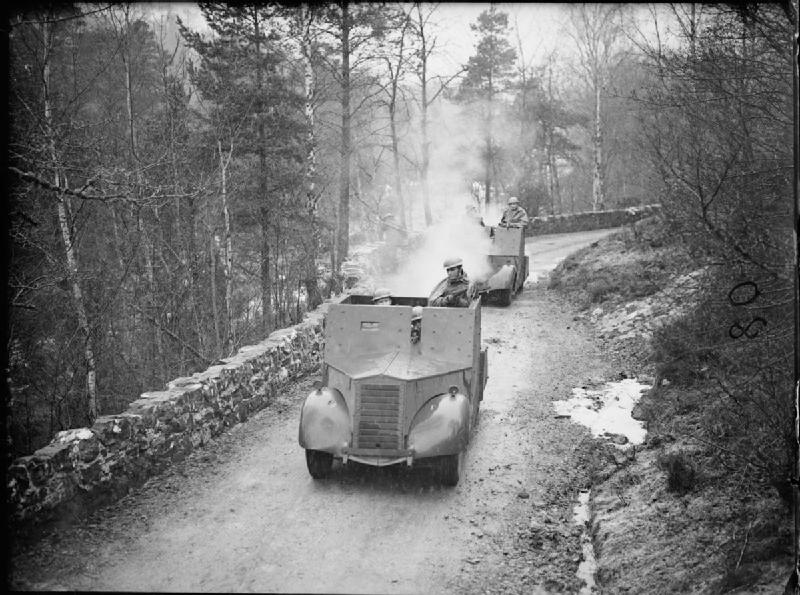
Home Guard unit in the Highlands of Scotland, 14 February 1941
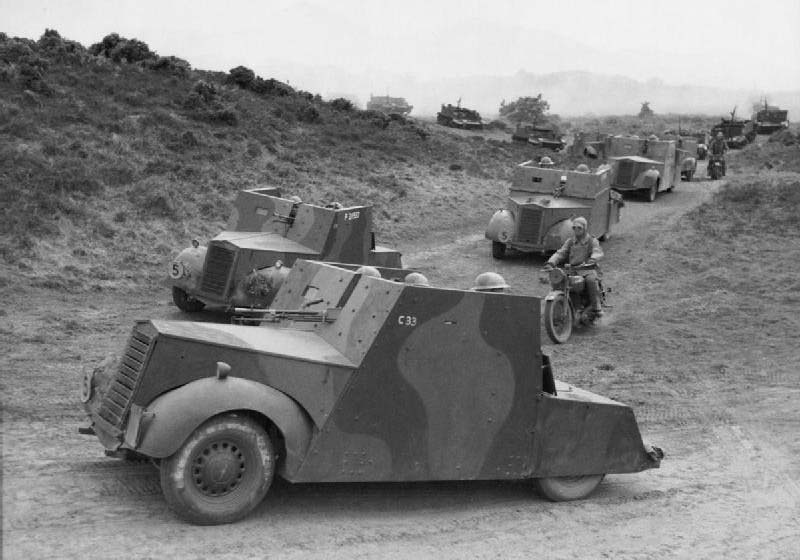
53rd Battalion The Reconnaissance Corps during manoeuvres at Ballykinlar in Northern Ireland, 19 June 1941
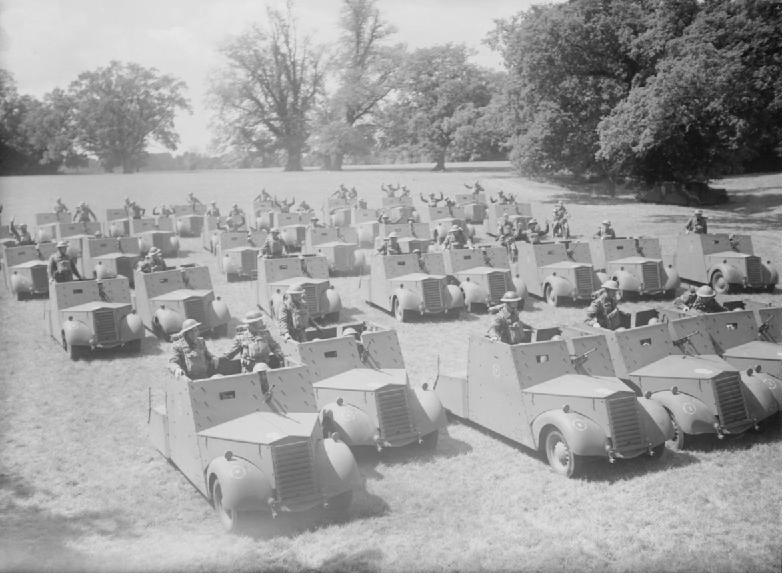
The 4th/7th Royal Dragoon Guards, Royal Armoured Corps, 25 July 1940.
The Bison was an extemporised armoured fighting vehicle often called a mobile pillbox. In 1940 the RAF needed AFVs to protect the airfields and the Bison was an ad hoc solution. In addition to the RAF, they were also used by the Home Guard.
The Bison was the designed by Charles Bernard Mathews who was an ex Royal Engineer and now a director of Concrete Limited. The company trademark was a Bison, and thus became the name of these vehicles.
The idea was to take an old lorry chassis and add a concrete fighting compartment. Because of the different types of chassis used, there was no standard Bison, but they were made in three distinct types:
-
Type 1 was the lightest. It had a fully armoured cab and a small armoured fighting compartment roofed with canvas.
- Type 2 had an armoured cab roofed with canvas and a separate fully enclosed fighting compartment resembling a small pillbox with concrete roof on the back. The pillbox crew entered through a trapdoor in the floor.
- Type 3 was the largest and heaviest. It had a contiguous cabin and fighting compartment completely enclosed in concrete armour.
Concrete was used to cover the engine and cab at the front and to create pill-box at the back.
The pillbox walls were about 6 inches (150 mm) thick and were tested against rifle and LMG (Bren Gun) bullets
but would not have been proof against heavy weapons.
This was not seen as a problem, as airborne troops are not expected to have many heavy weapons.
Armoured shutters were fitted over the rifle slits.
Communication between driver and crew must have been difficult on the type 1 and 2.
The vehicle had a very poor power-to-weight ration, but luckily the airfields they were to defend were flat hill-less terrain with good runways and taxiways and no boggy ground. It was expected that in the event of an airborne attack, the Bison would be deployed onto the airfield and there fight as static pillboxes.
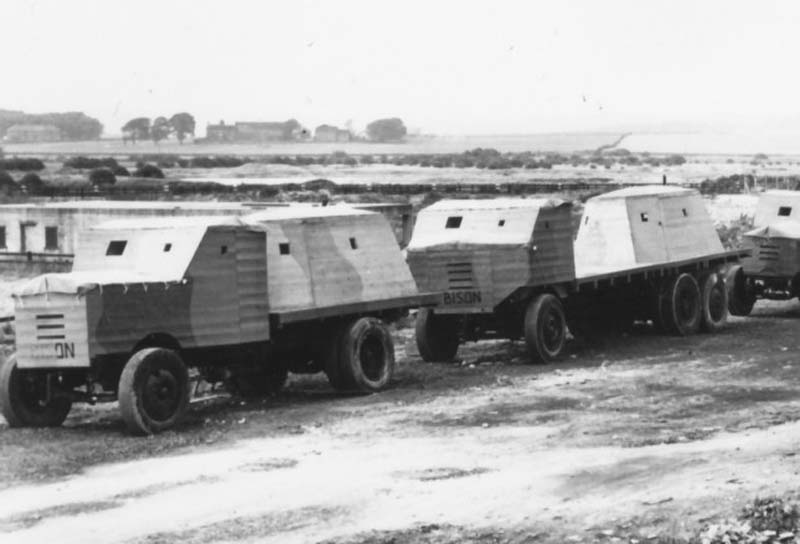
Bison type 2
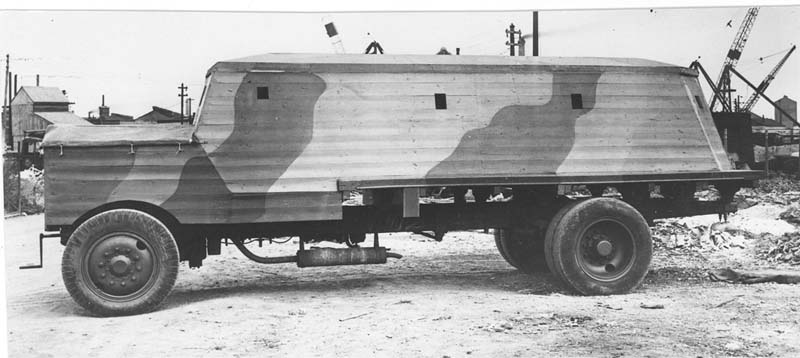
Bison type 3
Churchill was informed that there were not enough anti-tank guns available for the defence of Calais, he therefore ordered that naval 12-pounder (3-inch, or 76.2mm) guns be mounted on lorries. These were obsolescent WW1-vintage guns first introduced in 1894.
There is however no record of any actually being shipped accross the channel.
Instead, these lorry mounted 12-pounder guns were used by British home defence forces in Kent from mid 1940.
Originally, during WW1, the 12-pounder fired a 12.5 lbs AP HE projectile with a range of 10,900 yards (9,970 m) and had a rate of fire of 12-14 rounds per minute. Between the wars the projectile weight increased to 16 lbs and the range to 12,950 yards (11,810 m). The 12 pounder had telescopic sights.

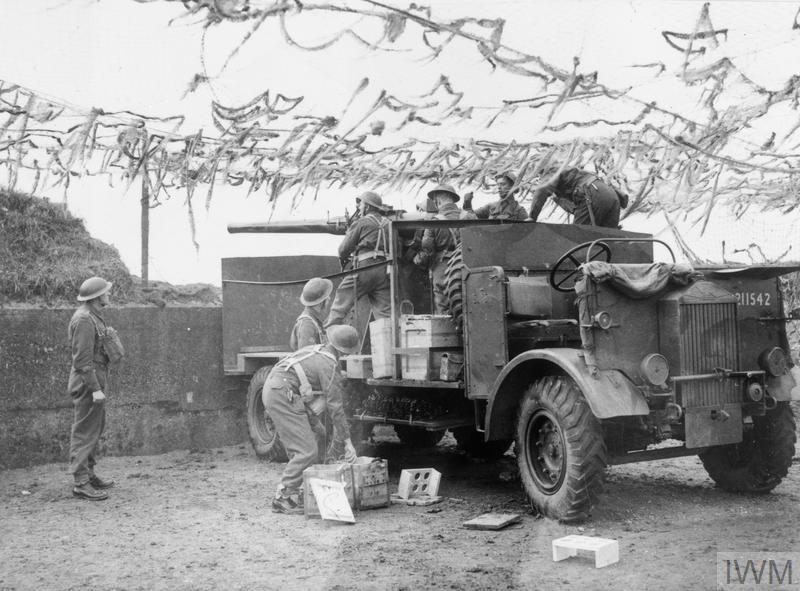
The Northover Projector was an ad hoc anti-tank weapon used by the Army and Home Guard during the Second World War. It was designed by a Home Guard officer named Robert Harry Northover to act as a makeshift anti-tank weapon, and was put into production in 1940.
The weapon consisted of a simple smooth piece of iron drainpipe 2.5-inches wide, a breech assembly was set on one end to which a trigger was installed. A set of simple sights were fitted to the front and rear of the pipe and a set tripod was attached to the bottom. It only had about 16 parts, including the three legs and the spade blade attached to each. This meant that it was both cheap and could be produced by semi-skilled labor in great numbers.
Rounds were fired with the use of black powder ignited by a standard musket percussion cap, and it had an effective range of between 100 and 250 yards.
It was designed to fire the No.76 Special Incendiary Grenade which was basically a Molotov cocktail. For more info see
No.76 Grenade.
These had the unfortunate tendency to break inside the breech, damaging the weapon and injuring the crew.
Production began in late 1940 it remained in service late into the war by which time about 21,000 had been made. Of these 13,000 were the Mk.1 and 8,000 were a lighter Mk.2 version intended to make handling easier.
It was eventually replaced by "real" anti-tank weapons, such as the 2-pounder anti-tank gun.
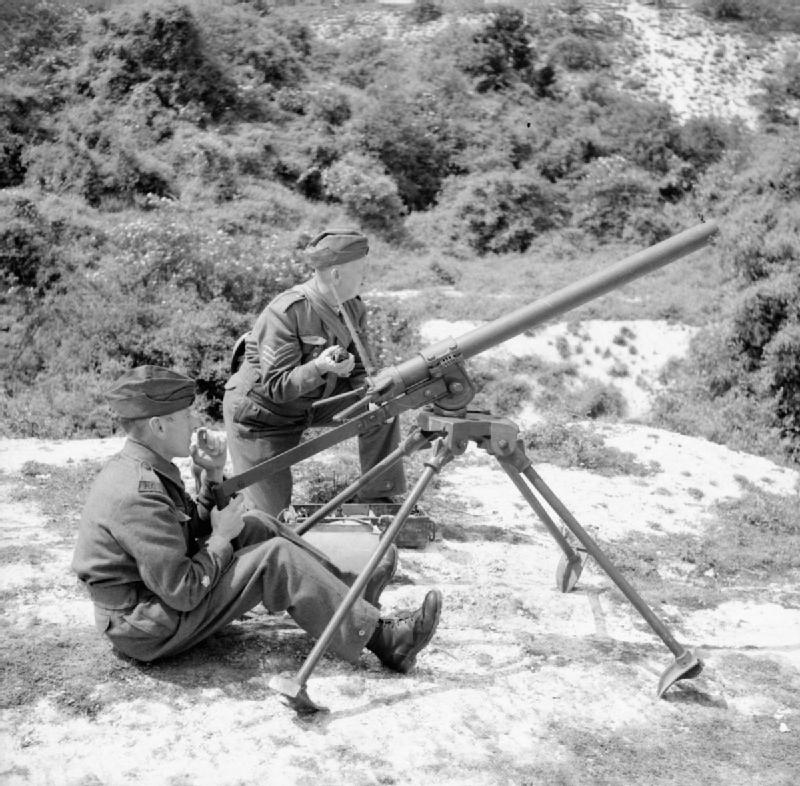
The No. 76 Special Incendiary Grenade also commonly known as the A.W. bomb (because it was made by Albright & Wilson of Oldbury) or SIP Grenade (Self Igniting Phosphorus) was an white phosphorus incendiary grenade not unlike a Molotov cocktail in design. They were manufactured from 1940 and by August 1941 over 6 million had been produced.
It was made of a glass half-pint lemonade bottle sealed with a crown cork and filled with a mixture of white phosphorus, benzene, water and a two-inch strip of raw rubber.
When it hit a hard surface, the glass would shatter and the oxygen in the air would cause the white phosphorus to ignite giving of choking fumes and a great deal of heat.
The No. 76 grenade was an ad hoc anti-tank weapon issued to the Home Guard. It could either be thrown by hand, or fired from a Northover projector. Firing from the projector needed a stronger bottle and they two types were colour-coded to avoid mistakes.
Unlike the Molotov cocktail, these were never tested in combat, but tests at Farnborough suggested that they - like the Molotov cocktail - would not be particularly effective against tanks.
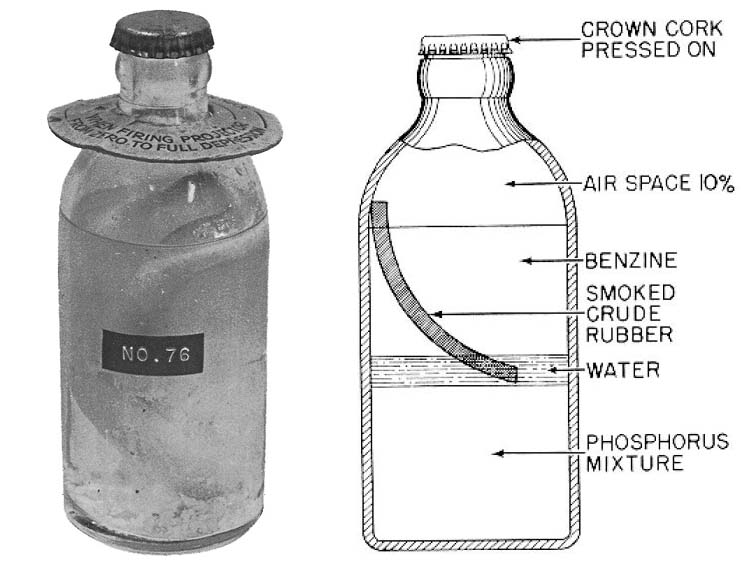
The Smith Gun was designed by a retired Army Major William H. Smith as a makeshift anti-tank weapon. Some sources say it was in service from 1940, but it was probably not in production before 1941. It was issued to Home Guard units, the RAF Regiment and regular army units guarding airfields.
The Smith Gun consisted of a 3-inch (76.2 mm) calibre smooth-bore barrel mounted on a carriage and capable of firing both modified 3-inch mortar anti-tank and anti-personnel rounds.
A basic gun shield was provided between the carriage's two wheels. When mobile the weapon lay on its side, so that to fire a Smith Gun had to be tipped over onto one of the wheels, which acted as a combined base plate and turntable (giving 360 degrees of rotation), while the other proved some overhead protection for the crew.
The gun and limber were light enough to be towed behind a civilian vehicle, although this was prohibited as the gun was not so designed. There was however such a shortage of ammunition (only half-a-dozen rounds per gun) that the limber was rarely used.
The Smith gun had theoretically in ideal conditions a range of 1,600 yards (1,500 m). In practice it had an effective range of between 100 and 300 yards (90–270 m) and a maximum range of only 500 yards (460 m). The anti-tank rounds were capable of penetrating about 60 mm of armour.
The Smith Gun initially gained a terrifying reputation for killing its crew but Home Guard units developed an attachment to the weapon and later claimed it to be one of the best pieces of equipment ever issued to the force.

The Blacker Bombard, also known as the 29mm Spigot Mortar, was an ad hoc anti-tank weapon designed by Territorial Army Lieutenant-Colonel Stewart Blacker during the 1930's. It was designed to be cheap, simple to manufacturer and easy to operate. The idea was that it would act as a temporary anti-tank weapon for the Home Guard until 2 pounders could be supplied.
The Blacker Bombard was a 29mm smoothbore gun that could fire a 20lb anti-tank or a 14lb anti-personnel projectile with a range of 100 yards (91m) with a rate of fire of 6–12 rounds per minute. It was inaccurate and its ability to penetrate a tank's armour was debatable. It had a crew of 3-5 men and was man-portable.
The first Bombards appeared in late 1941. In the regular army, twenty-four Blacker Bombards were to be issued to anti-tank regiments and twelve to troops assigned to guard airfields. Each Home Guard company was to get two Blacker Bombards.
More than 22,000 were manufactured between 1940 and 1941.
It appears that a number of Blacker Bombards saw action with Australian units in an anti-personnel role in the Western Desert Campaign. It is uncertain where these weapons came from, but as they were used by the RAF for perimeter defence, it was suggested that the Australians got them from airfields in the Canal Zone.
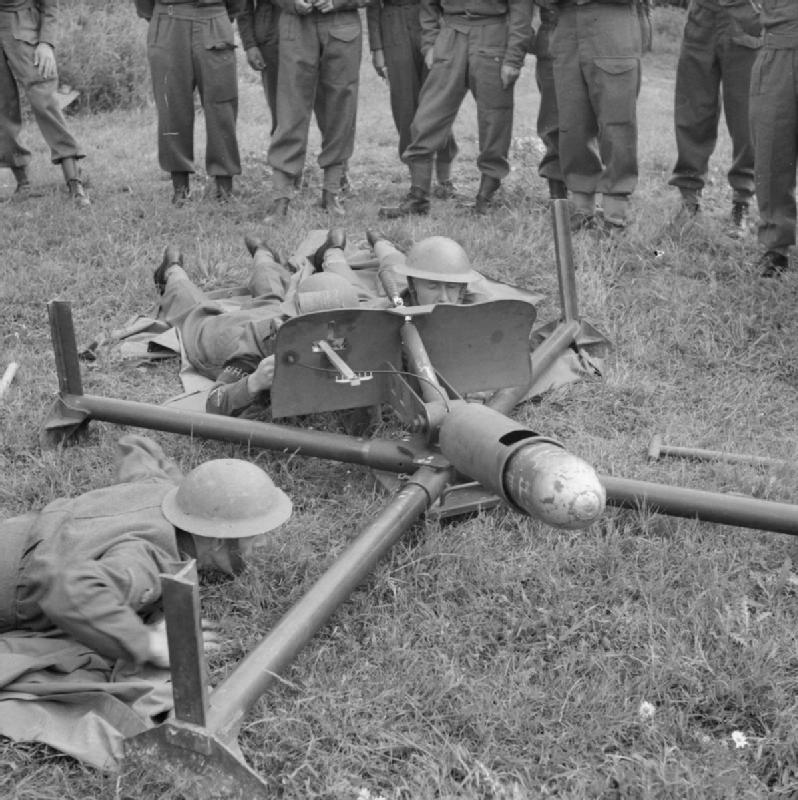
Men of the Saxmundham Home Guard prepare to fire a Blacker Bombard during training, 30 July 1941.
The No. 74 Anti-Tank Hand Grenade commonly known as the sticky bomb or S.T. Grenade (S.T. stands for Sticky Type) was an anti-tank weapon developed for use by the British Army and Home Guard as an ad hoc solution to a lack of sufficient anti-tank guns in the aftermath of the Dunkirk evacuation.
The grenade consisted of a glass sphere containing about 1 1?2 pounds (680 g) of explosive made of nitroglycerin and additives (this added stability to the mix, as well as giving it its squash-head-like effect) covered in a strong adhesive and surrounded by a sheet-metal casing. When the user pulled a pin on the handle of the grenade, the casing would fall away and expose the sticky sphere. Pulling another pin would arm the firing mechanism and the user would then attempt to attach the grenade to an enemy tank or other vehicle. Letting go of the handle would release a lever that would activate a five-second fuse, which would then detonate the nitroglycerin.
According to the from training manual:
This grenade has been introduced for use against light A.F.Vs. It is designed to stick to a suitable target, thus ensuring that the high explosive has its maximum effect. The grenade will NOT stick should the surface be wet or muddy.
The grenade is suitable for use at road blocks, positions of ambush, or for dropping from upstairs windows on to tanks.
Although the effect of the explosion is localised, the thrower must take cover owing to the blast.
For night raids on tank parts, the grenade is an ideal weapon. It can be regarded as a portable demolition charge and planted by hand instead of thrown, so long as the operator retreats in such a direction that he is protected from the explosion. With practice and training, the grenade can be thrown up to about 20 yds.
Churchill wrote a memo in October 1940 which read "Sticky bomb. Make one million". By July 1941, 215,000 sticky bombs had been produced, mainly for use by the Home Guard, but nearly 90,000 had been sent abroad to North and South Africa, the Middle East and to Greece where it did useful service.
Operational Use
Although the Ordnance Board had not approved use by the Regular Army, a number of sticky bombs equipped British and Commonwealth units participating in the North Africa campaign where they were used as anti-tank weapons. During the Afrika Korps advance towards the town of Thala in February 1943, they destroyed 6 German tanks.
They were issued to the Australian Army, who used them during the New Guinea campaign. They were also supplied to the French Resistance.
"A section of the Royal Durban Light Infantry used these bombs to great effect in what amounted to a battle between men and tanks. The South Africans, armed only with a Bren-gun, a Spandau-gun, a tommy-gun, and anti-tank rifle, sticky bombs, and hand grenades, took on an enemy formation consisting of 28 tanks which was advancing in "W" formation against the position that the section was holding. The South Africans waited until the leading tank was 10 paces away and then pelted it with sticky bombs, setting fire to it and forcing out its crew, who were all shot down. Four tanks were dealt with in this fashion and 28 Germans were killed."
Men Versus Tanks — The Times. 6 August 1942.
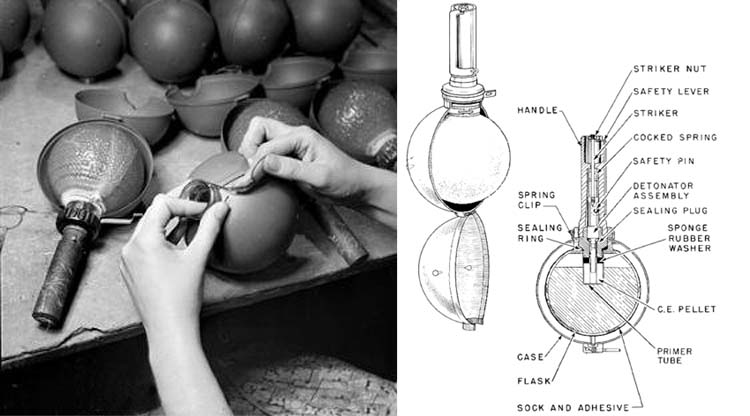
The Armadillo was an extemporised armoured fighting vehicle. In 1940 the RAF needed AFVs to protect the airfields and the Armadillo was an ad hoc solution.
The Armadillo was a lorry with a box-like fighting compartment mounted on the back. The box was made of 7/8 inch (22 mm) thick wooden boards measuring about 4 by 5 feet (1.22 by 1.52 m) and standing 4 feet 6 inches (1.37 m) high. Inside this box, was a similar slightly smaller box leaving a gap of 6 inches (15cm) between them which was filled with gravel.
The fighting compartment had an open top with a beam across it to support a Lewis Gun on a sliding mount. The drivers and the engine were protected by steel plates.
Most Armadillos had a crew of 5 armed with two Lewis Guns and three rifles.
The fighting compartment was proof against rifle and machine gun bullets but not heavy weapons. This was not seen as a problem, as airborne troops are not expected to have many heavy weapons.
The vehicle had a very poor power-to-weight ration, but luckily the airfields they were to defend were flat hill-less terrain with good runways and taxiways and no boggy ground.
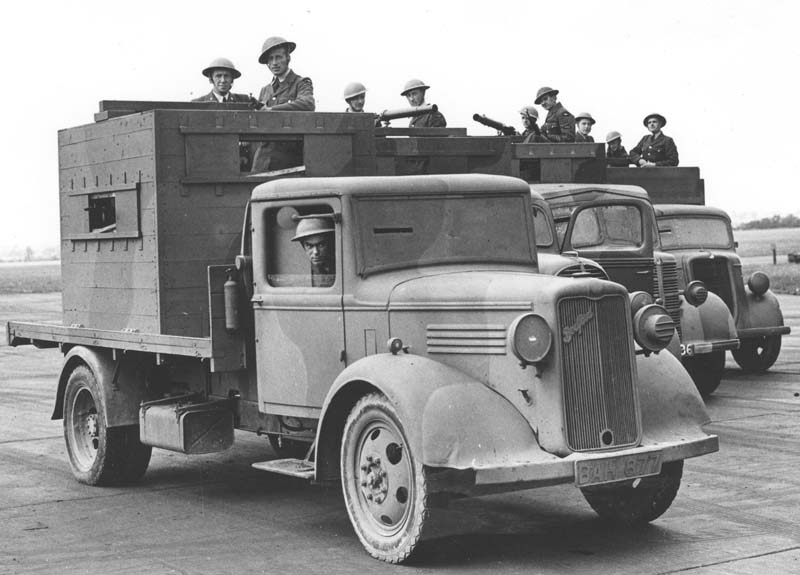
|